How Much Do Landing Pages Cost? The Complete Breakdown
Published Jul 28, 2025 | Updated Aug 27, 2025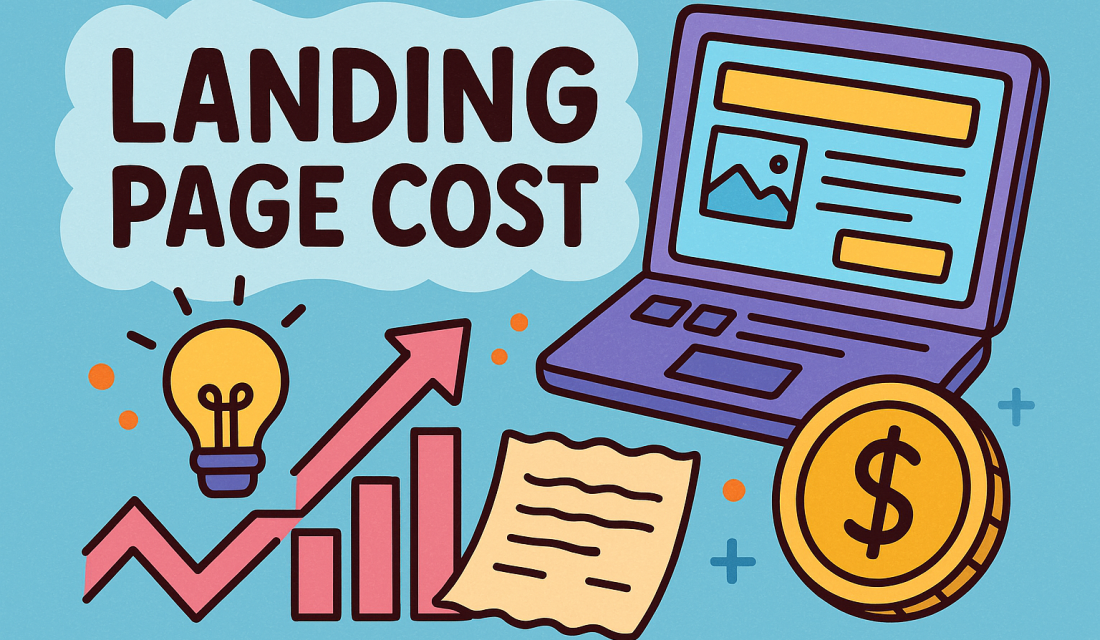
How much should you pay for a landing page? You need a high-converting landing page to capture leads and grow sales, and pricing varies wildly.
Whether you’re launching a product, collecting leads, or driving webinar signups, knowing what you’ll pay (and why) is crucial.
According to marketing studies, businesses boost their conversion rate by up to 35% with optimized landing pages. Grammarly, for example, used targeted landing pages to grow from 1 million to over 30 million daily users.

In this guide, we’ll break down the true cost of landing pages — and which option fits your growth goals.
- Landing Page Pricing Comparison Table
- Landing Page ROI: Does it Drive Sales and Revenue?
- Key Factors Influencing Landing Page Pricing
- Landing Page Cost: The Best Options
- 1). DIY Landing Page Builders: Affordable but Limited
- Pros:
- Cons:
- 2). Freelancers vs. In-House Developers: Mid-Range Options for Growing Brands
- 3). Custom Agency Builds: Premium, But Performance-Focused
- 4). Template Marketplaces: Low-Cost, Fast, and Plug-and-Play
- 5). Hidden & Ongoing Costs to Factor In
- Short vs. Long Landing Pages: Which is Better?
- Final thoughts
Landing Page Pricing Comparison Table
Below is a quick comparison of landing page pricing options to help you choose what fits your goals, budget, and growth stage.
| Option | Estimated Cost | Best For |
|---|---|---|
| DIY Builder (e.g., Leadmount, Carrd) | $0-$99/month | Solopreneurs, early-stage businesses. |
| Template + Freelancer | $300-$800/one-time | Small teams, side hustles. |
| Fully Custom Freelancer | $800-$2,500/one-time | Growing brands with design needs. |
| Agency Design | $2,500-$10,000/one-time | Large campaigns, high-ticket offers. |
| In-House Team (Dev + Designer) | $300/month (salaried) | Enterprise brands, ongoing testing. |
| Landing Page SaaS (e.g., Unbounce, Instapage) | $79-$299/month | Marketers who need full testing control. |
Landing Page ROI: Does it Drive Sales and Revenue?
Yes, landing pages drive sales and revenue — when done right. They’re designed to focus attention, eliminate distractions, and guide visitors toward one clear action: signing up, buying, or booking.
HubSpot Marketing Benchmark Reports revealed that companies with 10–15 landing pages increase leads by 55%, and those with 40+ see a 500% boost.
Here’s why: Well-optimized pages target specific customer pain points and match them with tailored offers.

Take Moz, the SEO software company, for example. They used targeted landing pages to promote a 30-day free trial.
The strategy was simple: they customized the content and CTA for different keywords and ad groups, and saw a 52% increase in trial signups, leading to $1 million in revenue. They also significantly reduced their cost per lead.

Source: CRE
This landing page strategy not only grew Moz’s lead volume — it directly boosted free trial users into paying users.
That’s the power of a focused, well-tested landing page: it converts, nurtures, and drives revenue.
Key Factors Influencing Landing Page Pricing
How much should a landing page cost? Several elements influence the cost of creating a landing page:
- Design complexity: Custom designs with unique elements usually cost more than template-based designs due to the additional time and expertise required.
- Copywriting: Professional copywriting services can add to the cost but are crucial for high-converting pages, as persuasive copy drives better results.
- Development: The technical expertise required for coding and integrating features affects the overall price, with custom development typically costing more.
- Integrations: Adding online shopping features and payment options increases the cost.
- Turnaround time: Urgent projects may incur higher costs due to expedited work.
- Revisions and Testing: Multiple revision rounds and A/B testing can add to the overall expense.
Landing Page Cost: The Best Options
You have several options when it comes to getting a landing page. Each comes with pros, cons, and pricing structure. Let’s explore them:
1). DIY Landing Page Builders: Affordable but Limited
If you want to quickly launch a landing page for your project, a DIY landing page builder such as Leadsmount can be very helpful.
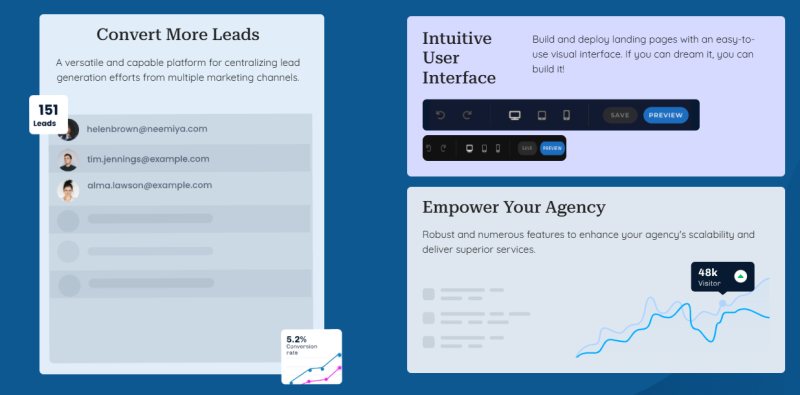
You can use the drag-and-drop interfaces to quickly design and launch a landing page. No design skills are required.
DIY landing page builders are affordable. Platforms such as Leadsmount offer plans starting at $49/month, featuring intuitive user interfaces and pre-designed templates.
Better yet, you can try the “Growth” plan FREE for 30 days. Sign up here.
Pros:
- Affordable pricing is suitable for small businesses and startups.
- User-friendly interfaces require no coding knowledge.
- Quick setup with various templates and customization options.
Cons:
- Limited customization compared to bespoke designs.
- Potential scalability issues as business needs grow.
- Ongoing subscription fees can accumulate over time.
2). Freelancers vs. In-House Developers: Mid-Range Options for Growing Brands
When you’re ready to move beyond DIY tools but aren’t quite prepared to invest in a full-blown agency, hiring a freelancer or using your in-house developer can offer the perfect balance between cost and customization.
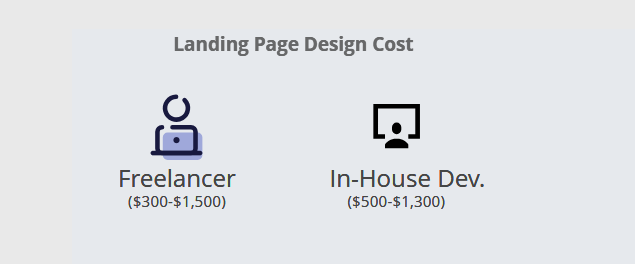
Freelancers typically charge between $300 and $1,500 per landing page, depending on their experience, the complexity of your request, and turnaround time.
Platforms like Upwork and Fiverr make it easy to connect with talented designers and developers globally.

Many freelancers offer bundled packages that include copywriting, light A/B testing, and responsive design.
Hiring an in-house developer or designer is a more scalable option if you plan to create multiple landing pages regularly.
While the cost is hidden in salary, you gain more control, faster updates, and consistent brand alignment across pages.
However, the true cost depends on how many projects you assign and whether you pair them with a marketer or copywriter internally.
Quick Tips:
- Always ask freelancers for a portfolio and references.
- Make sure they understand conversion best practices, not just visual design.
- If you go the in-house route, invest in training or tools that keep your team up-to-date with landing page trends.
Note: This middle-tier solution works best for scaling businesses with moderate design budgets and an appetite for experimentation.
3). Custom Agency Builds: Premium, But Performance-Focused
Custom-built landing pages developed by agencies come with the highest price tag — and often the most polished results.
According to Unbounce, the average cost of a high-performing landing page built by an agency ranges from $1,500 to $3,000.
Pricing can reach $5,000 if the project includes copywriting, conversion rate optimization (CRO), and advanced integrations.
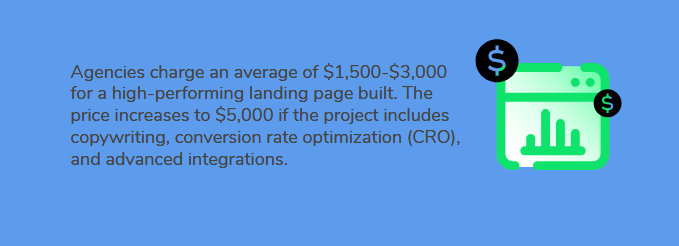
This option is ideal for brands running high-stakes campaigns, where every percentage point of conversion counts — such as Peloton launching a new product line and requires a professionally optimized landing page to drive pre-orders at scale.
Why Peloton? Peloton often runs high-investment campaigns for product launches (like the Peloton Row or revamped Bike+).
A 1–2% boost in conversion can mean thousands more in revenue, making expert landing page design a worthwhile investment.

Source: Mashable
Agencies often bring in CRO strategists, UX/UI designers, and expert copywriters to craft landing pages that align with your buyer journey and brand identity.
Some even offer ongoing A/B testing, heatmap tracking, and analytics reviews to optimize your results post-launch.
What you’re paying for:
- Deep expertise and proven frameworks
- Access to a full creative and dev. team
- Post-launch data analysis and improvements
When to use this option: If your brand has a high customer lifetime value or is running large paid media campaigns, investing in custom landing pages could significantly increase ROI.
Think of it as hiring a SWAT team for conversions: it’s expensive, but the precision and performance justify the spend.
4). Template Marketplaces: Low-Cost, Fast, and Plug-and-Play
Template marketplaces like ThemeForest, Creative Market, and Carrd offer plug-and-play landing page templates for as low as $10 to $80.
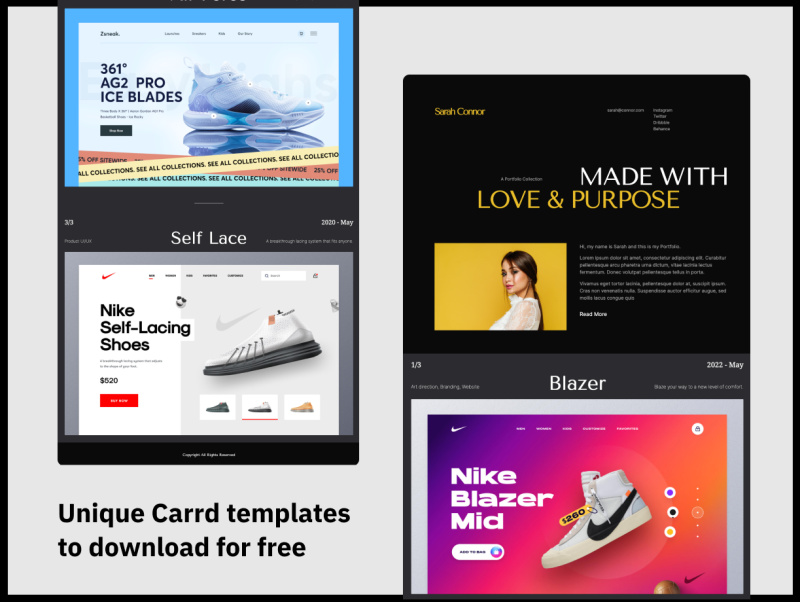
These landing page templates are ideal for solopreneurs or marketers on a tight deadline who need to launch fast without breaking the bank.
You’ll find hundreds of industry-specific landing page templates optimized for lead generation, sales, event signups, and more.
Many are compatible with platforms like WordPress, Webflow, or Shopify, and some include light animation, responsive design, and prebuilt forms.
However, what you gain in speed and affordability, you sacrifice in uniqueness and flexibility. These templates often lack:
- Brand-specific design elements.
- Custom features or interactive components.
- CRO-optimized structure out of the box
Pro tip: Choose templates that support easy editing and integrate well with your existing tech stack (CRM, email tools, etc.).
Also, check for licensing details — some templates don’t allow commercial use without an extended license.
Template marketplaces are when validating a campaign idea or building a temporary landing page (e.g., ‘Coming soon’ page).
Just don’t expect these templates to outperform custom or high-end builds. Think of them as the MVP (minimum viable product) for your marketing experiments.
5). Hidden & Ongoing Costs to Factor In
While the upfront cost of building a landing page gets all the attention, the real expenses often lie in the ongoing optimization, testing, and integration work after launch.
The table below illustrates the hidden costs of landing pages:
| Description | Estimated Price Range | |
| Domain & Hosting | Needed if self-hosted or using WordPress. | $10-$100/month |
| A/B Testing tools | Platforms like Optimizely or built-in tools in Unbounce. | $50-$300/month |
| Copywriting | Professional sales copy for better conversions. | $150-$1,000+/per page |
| Graphic Design Assets | Custom visuals, icons, or illustrations. | $100-$500/one-time |
| Integrations | CRM, email, and payment gateway connections. | $0-$100/month |
| Maintenance & Upgrades | Ongoing tweaks, speed improvements, or error fixes. | $50-$300/month (if outsourced) |
If you’re using a landing page builder, monthly subscription fees can also add up — ranging from $29/month for basic plans to $299/month for full-featured, high-volume campaigns (as seen with Unbounce, Leadpages, etc.).
Pro tip: Budget for a 3-month post-launch optimization period. That’s when you’ll gather enough data to identify what’s working and where to improve.
A great landing page isn’t built once — it’s continuously refined.
Landing pages aren’t just a cost; they’re an investment. Brands that succeed treat them like living assets, not static brochures — constantly tweaking to get closer to that perfect conversion rate.
Short vs. Long Landing Pages: Which is Better?
Both formats work—but in different contexts. The key is aligning the length of your landing page with the goal of your campaign and the awareness level of your audience.
Use this table chart to determine which style or format to use:
| Short Landing Page | Long Landing Page | |
| Audience | Warm traffic, returning users | Cold traffic, first-time visitors |
| Offer Complexity | Simple, low-commitment offers | Complex, high-ticket, or unfamiliar offers |
| Campaign Goal | Lead capture, trial sign-ups, and event registration | Sales, consultations, In-depth service adoption |
| Attention span/Device | Mobile-heavy or Ad-based traffic | Desktop users, organic or referred traffic |
| Persuasion Level | Low — already convinced or curious | High — need education, trust, and reassurance |
Short landing pages work best when your offer is simple, the audience is warm (i.e., they already know you), and the call to action is low-friction—think free trials, newsletter sign-ups, or downloadable lead magnets.
They’re quick to scan, mobile-friendly, and ideal for performance-based ad campaigns where attention spans are short.
MVP Chiro uses an engaging yet ‘short’ landing page, where the most important information appears ‘above the fold’ or with the “Hero section” of the page.
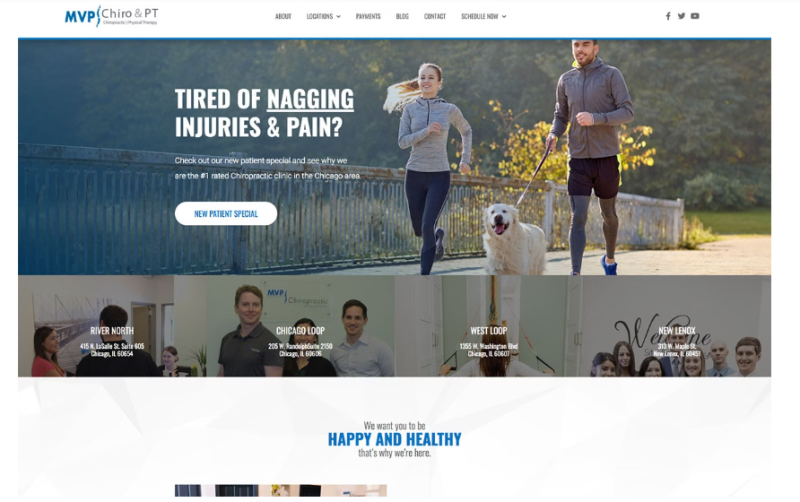
Long landing pages, on the other hand, shine when the product or service requires explanation.
If you’re selling a premium offer, launching a new concept, or trying to persuade a cold audience, a longer page allows you to educate, handle objections, build trust with testimonials, and guide visitors step-by-step toward conversion.
A great example is Zuzka Light, a Mobility Specialist, whose landing page stands out with its innovative design. It includes a unique sidebar opt-in area that expands when you hover over it, creating an engaging user experience.
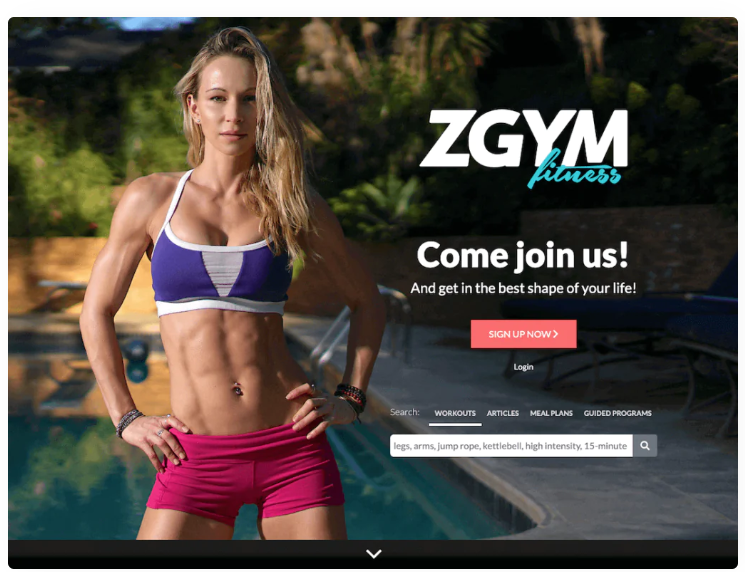
This is a long page, which strategically places key information—such as weekly workout schedules, on-demand access to a high-definition video library of 1,500+ easy-to-follow workouts, and toning tips—further down the page.
This design ensures that visitors can easily navigate and access the valuable content as they scroll.
Final thoughts
Your landing page should be one of the first things you invest in when planning your marketing budget.
They’re proven to increase conversions by up to 300%, especially when you design a landing page with your ideal customer in mind.
Brands like Lyft, which used optimized landing pages to grow driver signups, demonstrate that performance-focused pages can dramatically move the needle.
If your goal is to get more leads without overpaying for complicated tools or underperforming templates, Leadsmount helps you launch high-converting landing pages that actually work.
Whether you’re a solo founder or a growing team, it’s built to help you convert more visitors into paying customers—fast. Ready to boost results without guesswork? Visit Leadsmount.com/pricing to try it FREE for 30 days—no commitments, just conversions.

